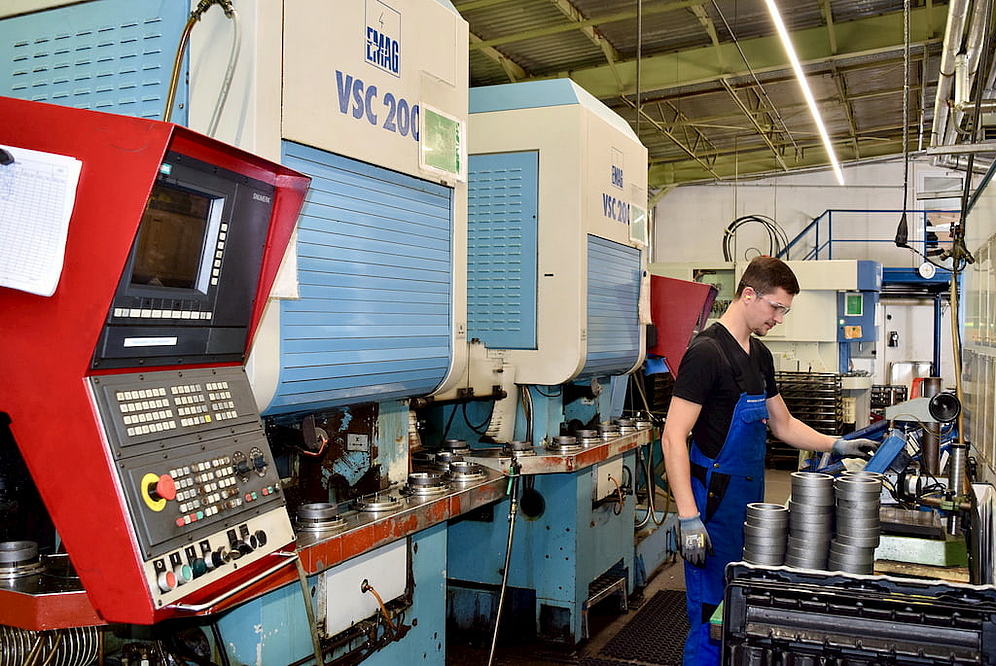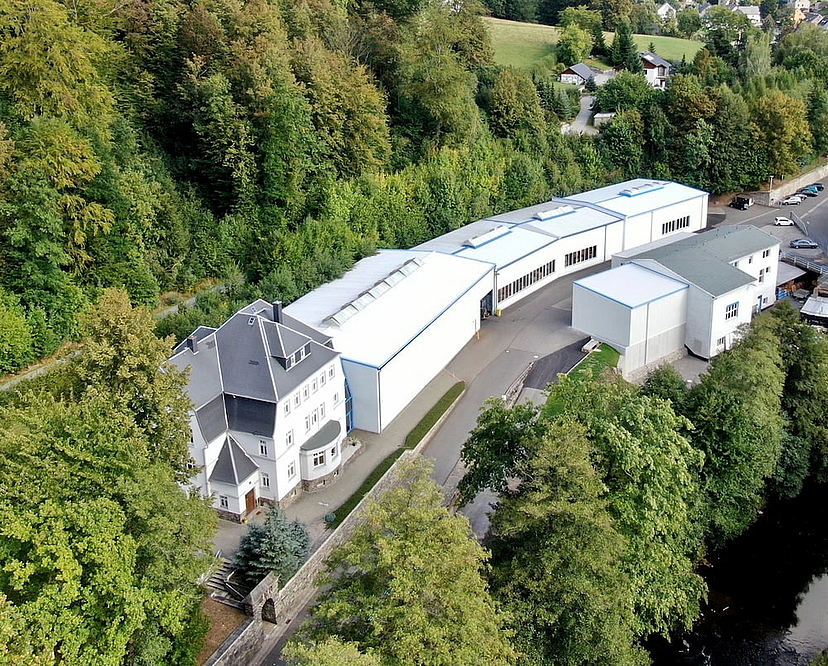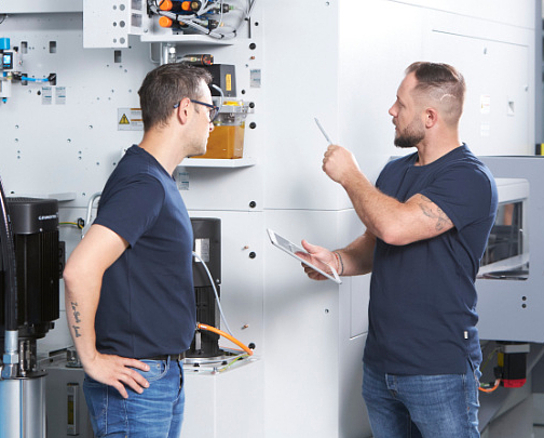14/12/2020 - Oliver Hagenlocher - Customer Stories
Specialized Parts Manufacturer in Saxony: Why Bäringhaus & Hunger have Relied on EMAG Pick-Up Technology for over 30 Years
What role does production technology play in the growth of a company? Especially when it has to be flexible to changing market conditions? Providing an impressive answer to this question is Bäringhaus & Hunger, based in Grünhainichen near Chemnitz. The company regularly relies on EMAG pick-up lathes for the establishment of new production capacities. Ultimately, it is always the same arguments that convince Bäringhaus & Hunger: integrated automation allows for lower investment costs and space requirements when compared to other machines with external gantry systems. At the same time, flexible technology allows new production solutions to be established quickly.
Images
From a three-employee business in a small warehouse, to a seasoned medium-sized company with 120 employees in just under 30 years -
Bäringhaus & Hunger can look back on an impressive success story. Today the company is responsible for the mechanical processing of many different parts with quantities ranging between 1 and 200,000 per year. The spectrum ranges from turned parts such as gearshift wheels, axle journals and joints to heavy-duty machined parts such as steering knuckles and milled aluminum parts such as crankcases.
Pick-Up Technology Convinces the Founders
Sustainable development began as early as 1991: shortly after the German Reunification, Gerd Bäringhaus and Reiner Hunger created the company at the site of an old paper mill in Grünhainichen. Initially, the founders were very satisfied with the small former warehouse, installing four used machines to produce wheel spacer sets for passenger vehicles. After just two years, the company had outgrown the old paper mill and was looking to expand. This was the beginning of Bäringhaus & Hunger’s long and successful partnership with EMAG: the company purchased a new VSC machine for the soft machining of ball hubs – a machine that had been recently launched to the market. At this time, EMAG was the only manufacturer to build a vertical lathe whose suspended work spindle could be moved to the main axes. Each machine of the VSC series was a complete production cell that loaded itself with a pick-up spindle – and this is exactly what convinced the managers of the still young East German company at the time! Shareholder Matthias Hunger confirms this; he and his brother Sebastian are the second generation of the family to run the company. “First, I must emphasize that adherence to delivery dates; flexibility and precision are our top priorities. In this respect, every new machine should fit with this philosophy. This has been the case with the original version of the VSC machine series: We got a high-performance solution including automation at an excellent price-performance ratio. The latter ensures speed. The operator places the blanks on the corresponding conveyor belt, and then removes them when they are finished. Everything else, including pick-up and clamping is done by the machine. The machine also guarantees very precise processes.
Positive Experiences Motivate Continued Investments
In the subsequent years, Bäringhaus & Hunger continues to experience tremendous growth with new orders from customers and the requirements for produced quantities both increasing rapidly. To meet the requirements of this growth, the specialists had to continue to invest, not just in EMAG technology, although it did continue to play a central role. By 1995, the company again needed to expand its facilities and introduced three-shift operations. On the new shop floor, two linked VSC machines from EMAG for the double-sided machining of articulated joints were launched. A turning station in the middle of the small line ensured the effective production flow. What experience with the first VSC machine ensures that just two years later this same technology will be chosen again? “For one thing, we were sold on this machine type because the first VSC run completely stable, error-free and fast,” answers Sebastian Hunger. “On the other hand, it was obvious to us the advantages that we would get with standardizing our turning technology within the company, relying on just a few manufacturers. This opens up our options: If it comes down to it, we can quickly change over additional machines and produce the desired delivery quantities”.
Small Footprint and Speed are the Key Factors
The specialists have remained true to this approach over the years. In 2001, they invested in the VL 3 and VL 5 modular standard machines, used for the machining of ball hubs. Then in 2015 branched into shaft machining with the purchase of a VT 2-4 – once again, Bäringhaus & Hunger opted for the “state-of-the-art” equipment of the time, with the ability to produce shafts up to 400 millimeters in length, and 64 millimeters in diameter. This machines strength is particularly evident when producing larger part quantities because the automation guarantees very fast chip-to-chip times. Workpiece grippers on the tool turret transport the raw parts into the machine, position them and remove them once machining it complete. Depending on the workpiece, the changeover times will only take a few seconds. In high-volume production, the short non-productive times add up to an enormous amount of time savings. The approach also guarantees energy-efficient production because machine tools consumer a large amount of energy during downtimes. The actual turning process – including 4-axis simultaneous machining and short non-productive times are also completed with extremely short cycle times. “For us, the space advantage also plays a role in the investment decision. The footprint of the VT 2-4 is very small because additional raw and finished part dispensers are not required,” adds Matthias Hunger.
Additional Investments to Follow
Over the course of 2020, the machining specialists have been recording the almost obligatory slump in sales due to the current economic crisis. However, since June, this trend has seemed to be reversing and production figures are beginning to rise again. “In August, we were only about 10 percent below where we were during the same month last year.” Explains commercial director Peter Mende. Currently, there are even plans to expand production with the purchase of a new lathe. An investment in EMAG technology is also a possibility in this context, as Managing Director Sebastian Hunger confirms. “Currently we have more than 20 EMAG machines. This means that almost the entire vertical turning operation within our company is completed by a single source with the help of standardized technology. This opens up an enormous amount of possibilities for us to bundle our capacities for large orders”. There is also another distinct advantage: the Saxon specialists have an enormous amount of experience in the configuration of the pick-up production process. For example, the workpiece carriers for complicated parts are designed in-house. The same applies to the process design of the machines.
30 Years and Going Strong
Against this background, every new EMAG machine installed at Bäringhaus & Hunger has been like a “stepping stone” for the establishment of new production processes – the latter being extremely important in the view of the growing price pressure in the automotive industry. Interestingly enough, in this connection Managing Director Sebastian Hunger even refers to a customer meeting in which it was confirmed that the company could keep up with the competition from the Far East. "Without the widespread use of fast pick-up automation, this would certainly not be possible," says Hunger. By the way, the first EMAG machine is still in use at Bäringhaus & Hunger - almost 30 years after its start of production. In its older days, it still performs simple turning tasks, “but we are still as satisfied as we were the day we received”, Matthias Hunger concludes.
Téléchargements
Interlocuteurs

Oliver Hagenlocher
Zone
Press and Communication














